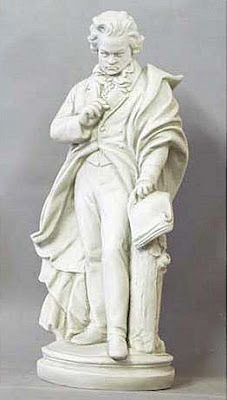Music can be looked at as belonging to one of two broad categories; absolute music or program music. Absolute music is music that has no apparent story attached to it, is not about anything, while program music has some sort of story or outside influence guiding it. Those two definitions are quite vague, but they can at least be taking-off points for a superficial categorization of music (if the listener needs one). Superficial for there are many instances of 'absolute' music that do have a story behind them, real or contrived. And program music also has a sense of absoluteness to it in that while it may be possible to relate specific actions through sound (the bird calls in Beethoven's Sixth Symphony come to mind), music's strength is in evoking an atmosphere or feeling rather than specific actions.
Franz Liszt and the creation of the tone poem put program music 'on the map', but music written to tell a story had been written long before that. Many composers used flutes to imitate birds, drums and trumpets to imitate martial music, horns to imitate the hunt. Music like this was not common, but it did exist. French composers of the Baroque era especially wrote music with a 'program', at least in the sense that the pieces carried a title that helped express the music. The French orchestral suite was developed into a form that made use of descriptive titles for the individual pieces, and Georg Philipp Telemann helped to popularize the French orchestral suite in Baroque-era Germany.
 |
| Don Quixote by Gustave Doré |
Friend to Handel and Bach (he was godfather to C.P.E. Bach), Telemann was born four years earlier than either and outlived both. One of the most prolific composers of his or any other generation (he composed some 3,000 pieces), he came from a family of mostly non-musical members, and except for a two-week stint of lessons with an organist had no musical instruction. He taught himself how to play many instruments, and composed sacred and secular music as well as music for the stage. He kept abreast of trends in the music of his time and was an important composer in the transition from the Baroque era to the Classical era.
Telemann's Suite For Orchestra 'Burlesque de Quixotte',by its very designation as a burlesque, is meant to be a light-hearted tribute to the novel Don Quixote by the Spanish author Miguel de Cervantes. The book was itself looked upon (and was written to be) a humorous one as the translation from the full title shows: The Ingenious Low-Born Noble Don Quixote of La Mancha. Telemann's suite is written for strings and consists of an overture with six titled pieces in the form of Baroque dances:
 |
| Miguel Cervantes |
Overture - Written in the French Overture style, the music begins with a slow section in dotted rhythms. After this, the tempo increases and the music becomes fugal. When the fugue is done, the slow tempo and dotted rhythms return and lead to the end of the overture.
Don Quixote Awakens - Don Quixote's dream to become a chivalrous knight on a quest for adventure and romance is begun, with long notes and pauses
Don Quixote Attacks The Windmills - In his rag-tag armor, make-shift helmet and lance, Don Quixote's delusions of grandeur have caused him to see windmills as monsters and dragons to be slain. The music's rapid tempo and repeated notes represent his imagined foes.
Pining For The Princess Dulcinea - Of what use is a knight's courage if he has no princess to fall in love with? Don Quixote imagines a peasant woman he has seen as his princess and names her Dulcinea, and longs to tell her how much he loves her. The strings play hushed sighs and the music stops and starts in sympathy with his feelings.
The Galloping Of Rosinante and Sancho's Galloping Donkey - Don Quixote's horse Rosinante is heard galloping in a steady in three tempo. Sancho's stubborn lurching donkey is portrayed in music that pauses and dotted rhythms. Rosinante is heard once again to finish the scene.
/>






.jpg)







_Titelblatt_(1874)%2Bcropped.jpg)